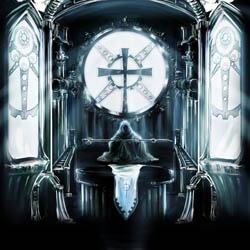
Texas U.I.L. Prescribed Music List
Available from C. Alan Publications
The Roman lyric poet Horace was one of the first to identify and warn young blossoming writers of the dangers of “deus ex machina” in his treatise, Ars Poetica. In many literary works of the time, a complex plot would be solved by having one of the classic Olympian gods arrive to fix all of the characters’ problems. Horace said of this practice that “a god should not intervene, unless a knot show up that be worthy of such an untangler.” Nevertheless, in the two millennia that have followed, countless authors have worked themselves into that same corner and used a convoluted and preposterous mechanism to allow their heroes to escape an otherwise certain fate.
Enter—in 2012—Daniel Montoya, Jr.’s Deus ex Machina.
Though not a literary work, Montoya’s composition for percussion ensemble makes reference at several levels to the technique. Speaking about writing for percussion, the composer says:
“One thing that percussionists can’t do well is sustain. Sure, we have the roll technique, but it’s hard to make it smooth like a string instrument, or as loud as a brass instrument. Also, it’s hard to get that rock concert bass sound and feel. And what if I wanted heavy taiko drums mixed with over-processed, distorted guitars? And a gospel choir… with Japanese children singing?!”
How does the composer solve this problem presented by the instrumentation? By including a preprogrammed electronic track that accompanies the live acoustic performers, in much the same way as his earlier Rumble Strips. The inclusion of the accompanying electronics provides a host of sonic possibilities that might otherwise have been unexplored. Montoya’s own version of a deus ex machina becomes even more literal, as we observe the power he harnesses out of the machine – not only does the electronic track expand the orchestrational world of the ensemble, but it also provides other benefits, such as a fixed and consistent pulse, and an ability to transition continuously while the live performers switch from one instrument to another.
Structurally, the piece falls into three major sections, each of which begins acoustically and then, with the introduction of the electronic component, increases rapidly in intensity. Although the three sections are stylistically quite varied, there are shared characteristics such as melodic elements that are rhythmically twisted to fit the character of the surrounding elements, but maintain their pitch contour. A recurring rhythmic motif—two tight groupings of three notes—implies the rhythm of the title of the piece: “De-us-ex / ma-chi-na.” Throughout, the composer draws new and interesting timbres out of the acoustic performance, using the electronic elements to augment, entice, and expand the already vibrant sonic world; a benevolent god, indeed.
Deus ex Machina is dedicated to Katie Leander.
Program note by Jake Wallace
Please credit Jake Wallace when reproducing or excerpting this program note